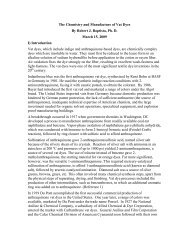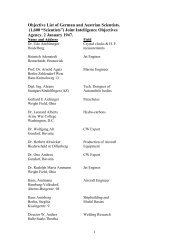International Dyestuff Industry - ColorantsHistory.Org
International Dyestuff Industry - ColorantsHistory.Org
International Dyestuff Industry - ColorantsHistory.Org
You also want an ePaper? Increase the reach of your titles
YUMPU automatically turns print PDFs into web optimized ePapers that Google loves.
against Simpson, Maule & Nicholson to make free the arsenic acid process for aniline red,<br />
and after 1865 his business grew rapidly. This also assisted Ivan Levinstein, from Berlin,<br />
who in 1865 began the manufacture of magenta at Blackley, Manchester; Levinstein’s<br />
factory was a forerunner of the present ICI Specialties.<br />
Litigation and the outcomes of patent disputes were also spurs to new innovative activities.<br />
Since routes based on the oxidations of aniline with arsenic acid were held up in Britain<br />
(except at Nicholson’s firm) until early 1865, because of injunctions, phenol-based colors,<br />
naphthalene colors, modifications of mauve, and exploitation of Peter Griess’s discovery,<br />
what was later called the diazo reaction, were all investigated. Heinrich Caro, a German<br />
colorist at Roberts, Dale & Co. in Manchester, the main rival of Simpson, Maule & Nicholson,<br />
was instrumental in directing research that led to all these colors. [15]<br />
Heinrich Caro, colorist, chemist and technical leader, at BASF,<br />
from 1868-1888. Edelstein Collection, Hebrew University.<br />
Aniline Black<br />
Caro invented a process for mauve in 1860, whereby copper salts were used as oxidants. It<br />
became the sole competitor to Perkin’s dichromate reaction and the Manchester-made<br />
mauve was used in Lancashire and Scotland from around 1862. From the residue of the<br />
reaction, Roberts, Dale & Co. extracted a black colorant suited to cotton printing. However,<br />
in 1862 it was used only to a limited extent by printers in Britain because of the corrosive<br />
action on printing machinery. It was more widely applied on the mainland of Europe, where<br />
wooden block printing was still popular.<br />
The original discovery of aniline black was made in 1859 by John Lightfoot of Accrington,<br />
north of Manchester. He established that the direct application of aniline in the presence of<br />
an oxidizing agent to cotton, using the engraved copper plates of cylinders of printing<br />
machinery, gave a fast and brilliant black, but, again, this was not wholly satisfactory<br />
because of the corrosion problem. Lightfoot eventually patented his process early in 1863.<br />
For mainland Europe and the United States patent rights were assigned to J.J. Muller- Pack<br />
of Basle.<br />
In 1864 Charles Lauth in Paris came out with the first of the improvements that were to<br />
make aniline black printing possible with machinery. This was through the use of insoluble<br />
copper salts. For the remainder of the nineteenth century, aniline black printing and dyeing<br />
was carried out on a vast scale. [16]<br />
Alkylation and phenylation of aniline<br />
Since the Renards retained exclusive control over the production of aniline red, blue and<br />
violet, chemists in Paris and Lyon also sought out new reactions on coal tar products. In<br />
addition, the Renards, which became Societe La Fuchsine in 1864 (backed by the Credit<br />
Lyonnais bank), had problems with pollution from large scale arsenic acid oxidation (from<br />
around 1862). For these reasons, amino group hydrogens of aniline and toluidine were<br />
replaced by phenyl and alkyi groups prior to oxidation. This work, inspired by Hofmann’s<br />
publications on the constitutions of aniline colors, led to the introduction of reactions carried<br />
out at high pressures and temperatures by Poirrier in Paris (alkylation, 1866), which<br />
enabled the Renards’ patents to be circumvented. It also led to the introduction of less





